A Comparison of SAP HEC with Virtustream Versus AWS
Executive Summary
- SAP is aggressively pushing HEC or HANA Enterprise Cloud and other private cloud providers.
- We compare HEC versus AWS.
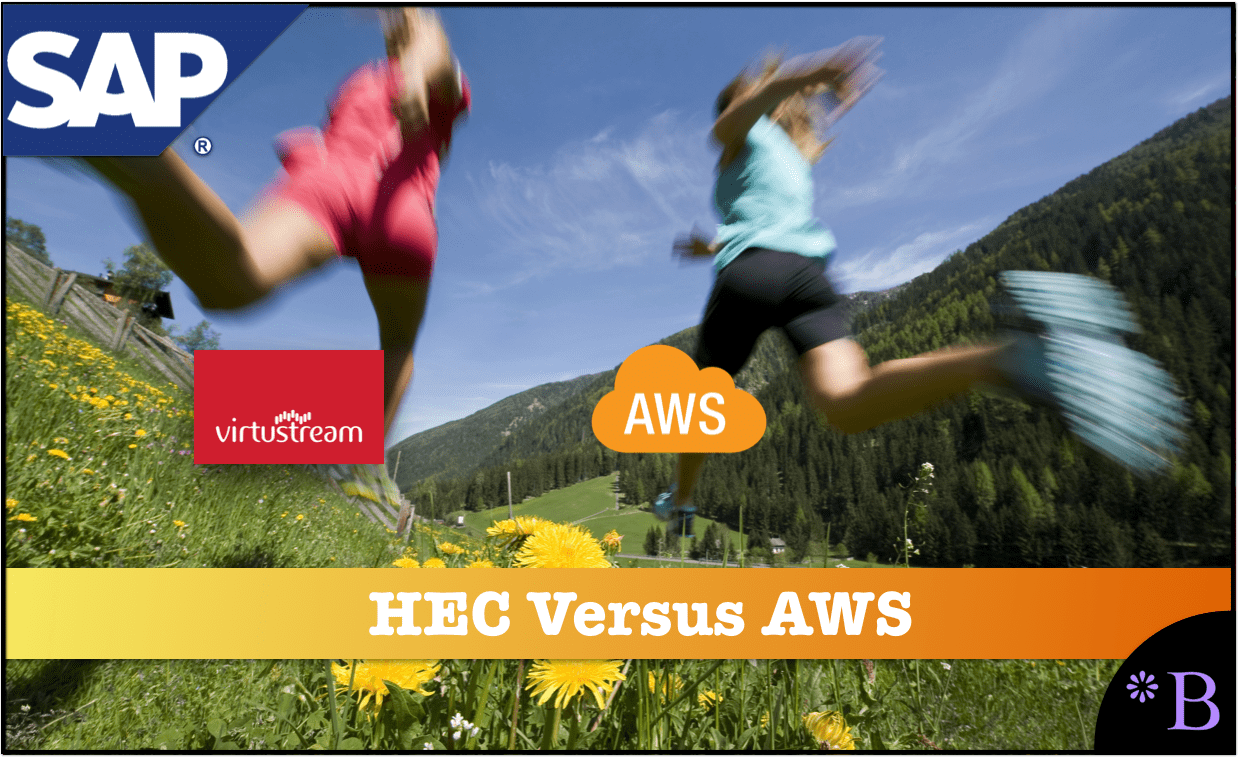
Introduction
Virtustream and AWS are two differently positioned cloud service providers. AWS is the largest cloud provider globally and was the early pioneer in the public cloud. Virtustream is a niche private cloud provider. AWS provides support for a wide variety of applications, and Virtustream is focused on SAP.
Our References for This Article
If you want to see our references for this article and other related Brightwork articles, see this link.
Notice of Lack of Financial Bias: We have no financial ties to SAP or any other entity mentioned in this article.
- This is published by a research entity, not some lowbrow entity that is part of the SAP ecosystem.
- Second, no one paid for this article to be written, and it is not pretending to inform you while being rigged to sell you software or consulting services. Unlike nearly every other article you will find from Google on this topic, it has had no input from any company's marketing or sales department. As you are reading this article, consider how rare this is. The vast majority of information on the Internet on SAP is provided by SAP, which is filled with false claims and sleazy consulting companies and SAP consultants who will tell any lie for personal benefit. Furthermore, SAP pays off all IT analysts -- who have the same concern for accuracy as SAP. Not one of these entities will disclose their pro-SAP financial bias to their readers.
The Comparison
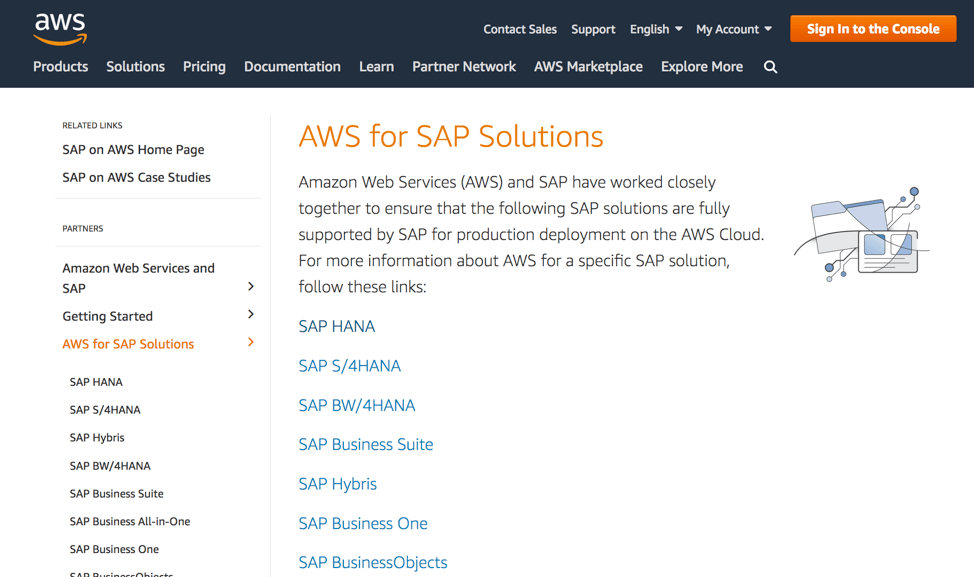
AWS supports some SAP applications. However, there are extra complexities to running SAP on AWS. One of the easiest items from SAP to run on AWS is HANA. SAP offers some HANA images on both AWS, GCP, and Azure under a free development license to entice people to use HANA. This does not extend to SAP’s applications.
Virtustream bristles at the comparison of AWS as a direct competitor. This is explained in the following quotation by the CEO of Virtustream.
“While AWS focused on serving scale-out cloud native applications, we architected our cloud platform to solve a different engineering problem: to run scale-up, I/O-centric enterprise applications that require higher availability and security.” – Diginomica
Part of this quote is more marketing positioning than a reflection of reality. Here are some interesting points.
- Scalability: It is unlikely that Virtustream can scale up to more than AWS, that it has higher availability than AWS.
- I/O: The points around I/O might be correct.
Security: Private cloud/hosting is considered a good fit for customers with the highest security requirements. But it is difficult to argue higher security than AWS, considering all of the security clearance focused government entities that use AWS.
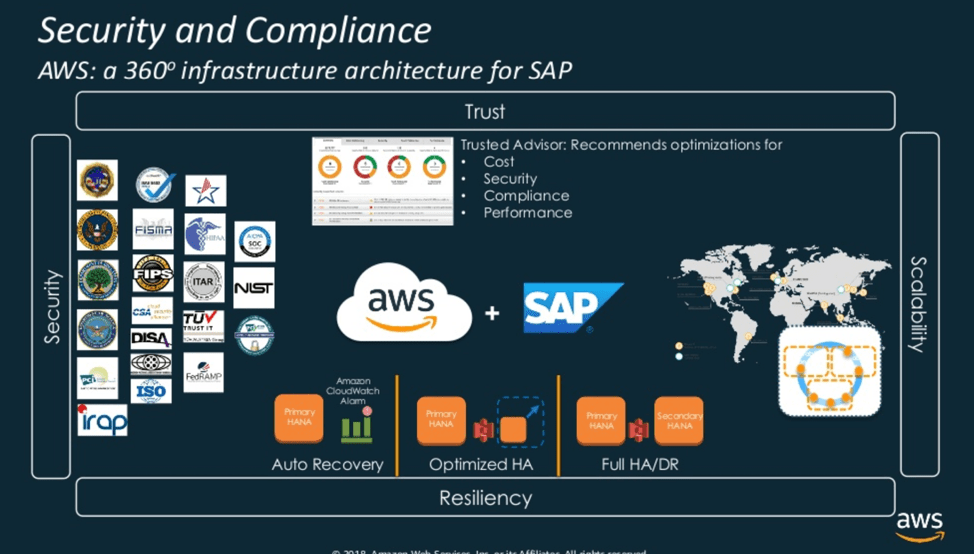
The previous points, combined with the fact that Virtustream is a private cloud, mean that Virtustream is a premium-priced offering over AWS. Virtustream uses miniaturized virtual machines, with their product called uVM, that it claims to improve resource utilization. Virtustream claims 250 production instances (that is 1000 SAP total instances, but 250 in production) of HANA and S/4HANA. This seems to be relatively small for a company that makes a big point about specializing in SAP.
The Comparison Matrix Provided
We found this comparison matrix sent to a client of ours.
Note that no “cons” are listed using HEC and Virtustream. However, there are, in fact, cons to using them. The only compared item that has any cons is AWS. The message from this comparison matrix is that AWS is clearly behind the compared providers.
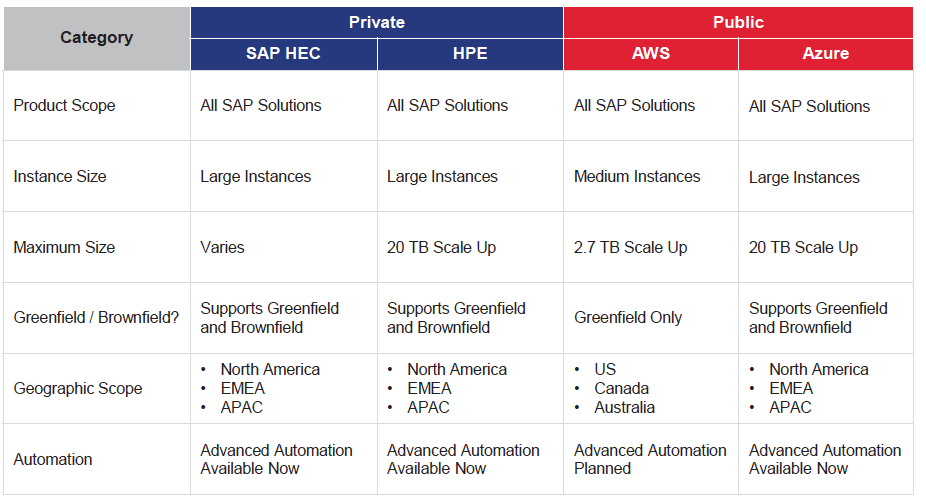
This matrix was received from the firm contracted to perform the procurement analysis.
This matrix does not do an excellent job of drawing the distinctions between the various cloud providers listed in the matrix. It appears designed to dilute the differences. Second, some of the differences listed in the matrix are inaccurate. The first impression is that this matrix was rigged to push the client down a predetermined pathway. That is the only way the matrix could be so precisely inaccurate.
Let us review each of the line items for accuracy.
- Instance Size?: According to the matrix, does AWS only support “medium instances?” First, AWS offers huge instances, and these are priced right on their website. This document will further show the large instance sizes available from the AWS website. Secondly, AWS has huge customers running large instances. This is exceptionally well known among those working in or researching cloud service providers.
- All Cloud Providers Lead AWS in Automation?: According to the matrix, AWS only has planned automation, while the other providers currently have automation. What services are considered automation in HEC, HPE, and Azure? It isn’t easy to understand what is meant here without more specifics. However, there are many automated services in AWS. Something to consider is that AWS is the leading innovator of cloud service providers. There is virtually nothing that other cloud service providers have that AWS does not have. Examples of automation in AWS include Chef for infrastructure automation. Another is AWS System Management Automation. And a third is Ansible for AWS. Overall, Brightwork ranks AWS in the leader category in automation.
- All SAP Products Work on All Service Providers?: This matrix proposes that one can run all SAP products on all the cloud service providers. That is incorrect. Not all of SAP’s products will run in the cloud. SAP has very few production instances in the cloud, particularly as a percentage of their on-premises numbers. SAP’s application has specific limitations that must be overcome during the migration/implementation. Overall, a low volume of SAP internally developed applications currently reside in a public cloud or are even hosted (private cloud). The vast majority of internally developed SAP applications are still delivered on-premises. Products like SuccessFactors or Ariba, primarily acquisitions in the cloud before SAP acquired them, are designed to run natively. Most S/4HANA on-premises versions of the application are on-premises rather than the private cloud/hosted.
- Greenfield Implementations?: Why does AWS only support Greenfield implementations? If the issue is one of hybrid cloud, both Cisco and VMware have introduced hybrid cloud extensions of AWS. This matrix may be dated as both VMware and Cisco hybrid extensions are recent developments.
- All Cloud Service Providers, But AWS Support EMEA and APAC?: Which three cloud service providers have the highest CAPEX in the world? The answer is AWS, Google Cloud, and Azure.
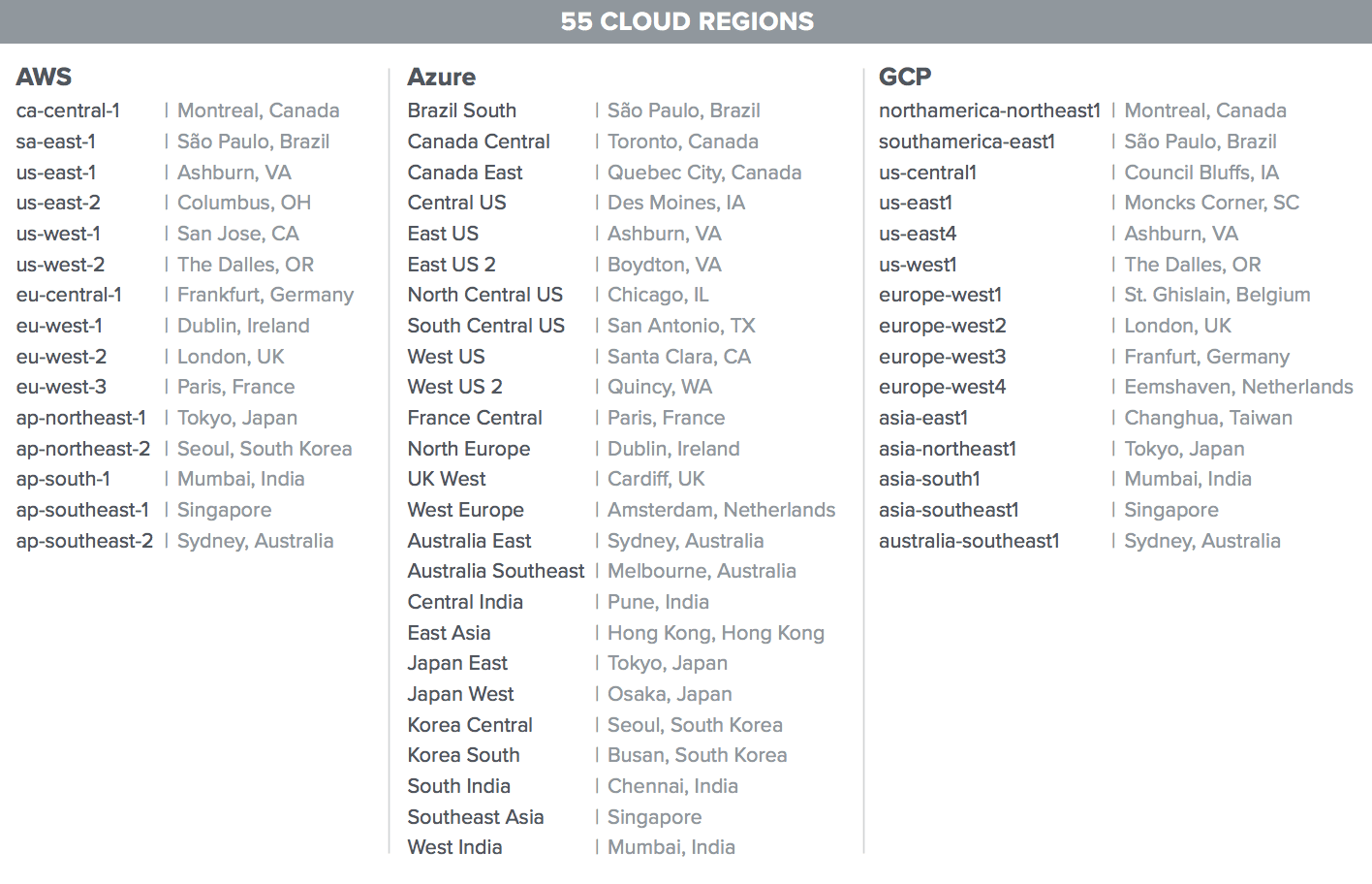
Where are the (supposed) missing data centers for AWS in EMEA and Asia?
The following few pages provide latency testing coverage, which contradicts the statement regarding AWS’s limitations internationally. For those interested in the main topic of the overall comparison, scroll past this section.
International Latency Testing
However, of the three hyper-scale cloud service providers, AWS lags Azure and Google Cloud in their network connectivity. This topic is covered in the research by ThousandEyes, a company that works in networking and network analysis.
“Why AWS chooses to route its traffic through the Internet while the other two big players use their internal backbone might have to do with how each of these service providers has evolved. Google and Microsoft have the historical advantage of building and maintaining a vast backbone network. AWS, the current market leader in public cloud offerings, focused initially on rapid delivery of services to the market, rather than building out a massive backbone network. Given their current position, increasing profitability and recent investments in undersea cables, it is likely that their connectivity architecture will change over time. Enterprises considering a move to the public cloud should consider connectivity architectures to evaluate their appetite for risk while striking a balance with features and functionality. Enterprises should also be aware that even though public cloud backbones are each maintained by a single vendor, they are still multi-tenant service infrastructures that typically don’t offer SLAs. Furthermore, public cloud connectivity architectures continuously evolve and can be subject to precipitous changes at the discretion of the provider.”
However, even though some differences give Azure and GCP advantages over AWS, the bi-directional latency was similar in testing.
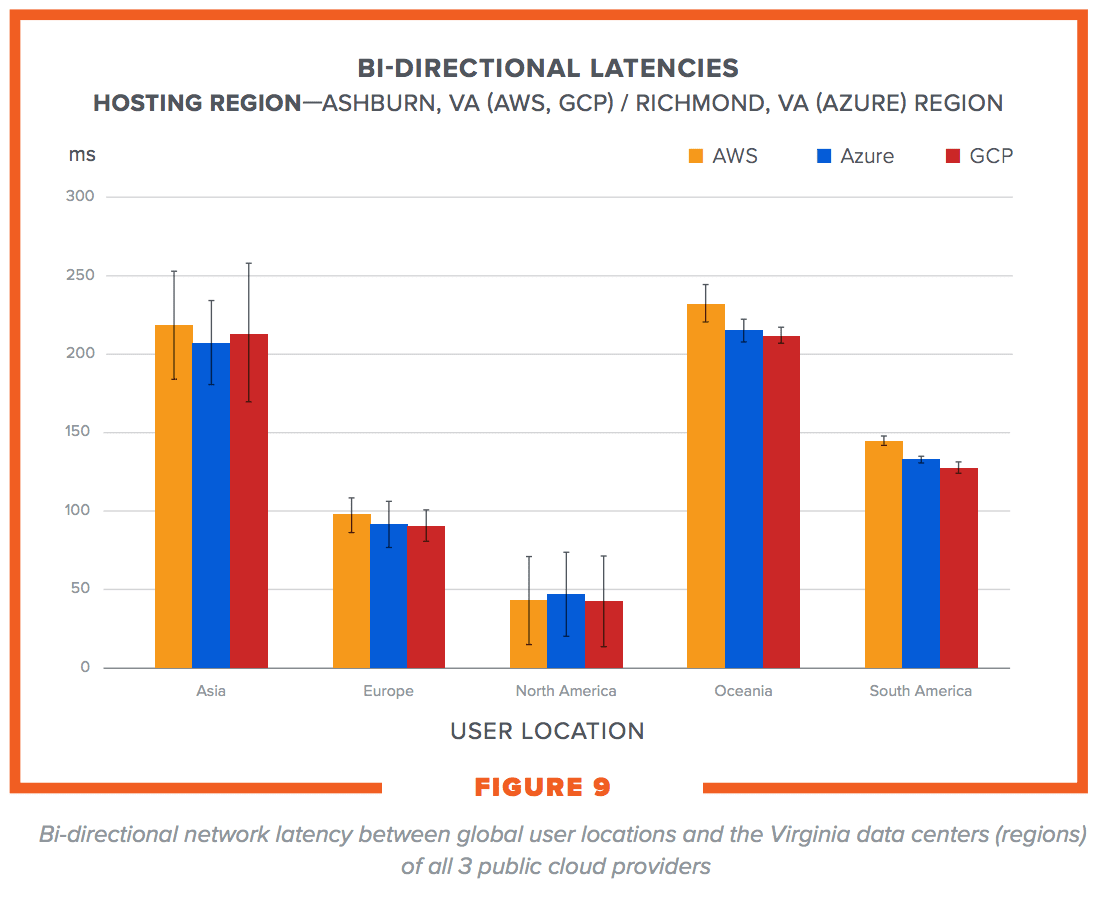
The results are quite close from the US to other regions, with AWS lagging somewhat in 4 of the five comparisons. But the differences are small.
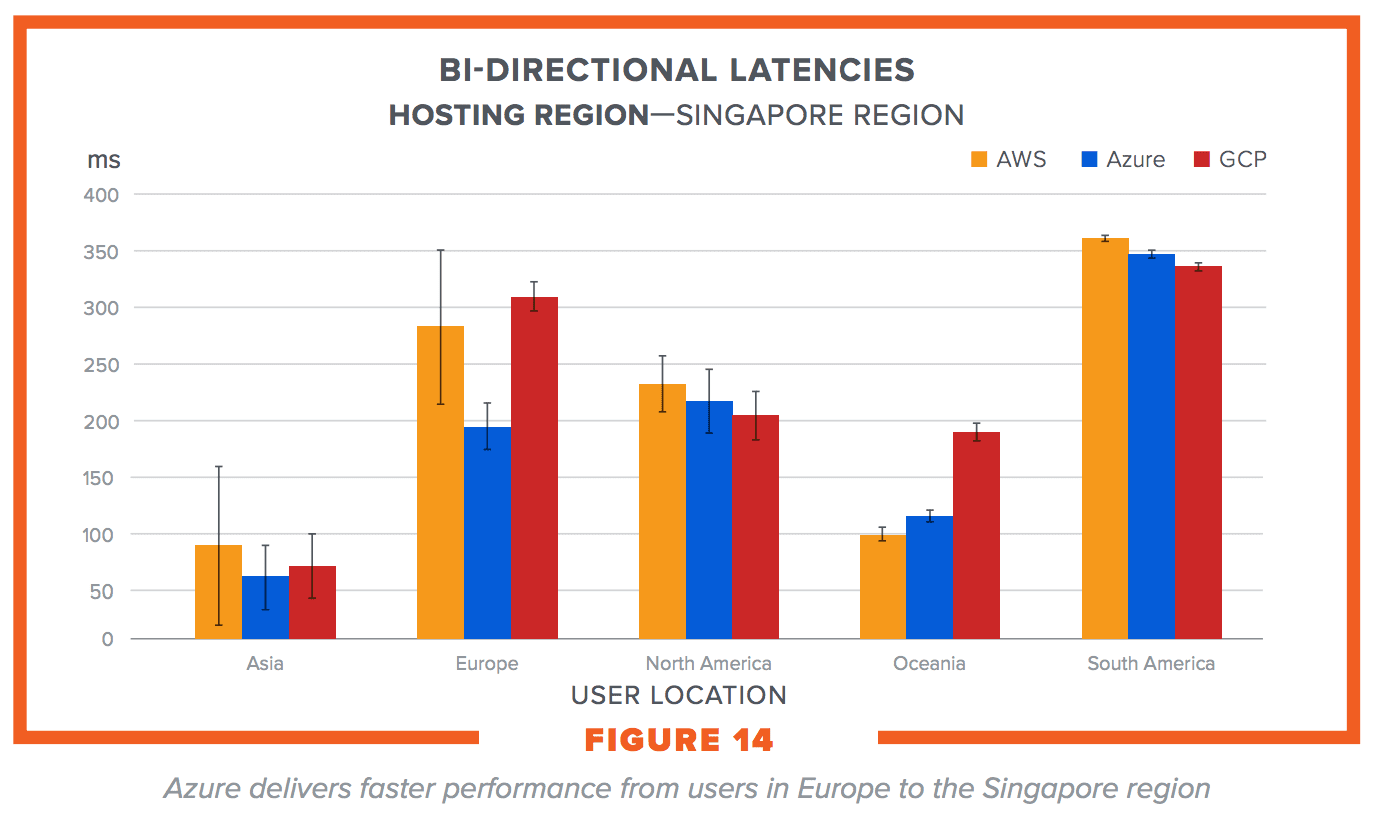
From Singapore, there is no discernible pattern of advantage between the three providers.
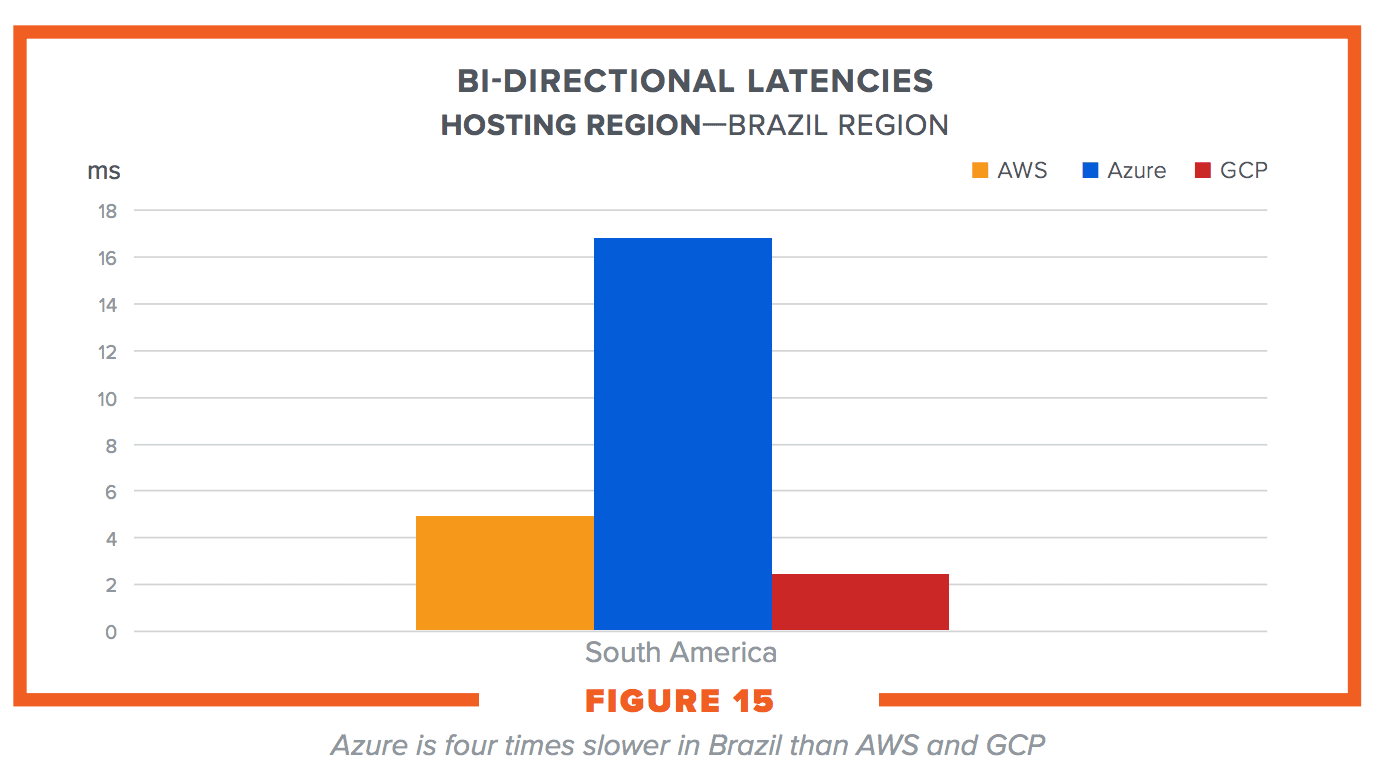
Azure appears to lag behind both other providers. Each provider only has one location in Central and South America.
Therefore, while AWS lags the other service providers in the physical infrastructure sense, the outcome is that AWS records a very similar performance to Azure and GCP.
There is no possible scenario where Virtustream would compare against AWS or the other two hyper-cloud service providers listed in the Thousand Eyes study, as Virtustream has far fewer data centers than any of these providers. Even Oracle has only four regions and has historically had a small cloud CAPEX versus the hyperscale providers.
Therefore, why is Virtustream listed in the matrix as having a more significant geographic scope than AWS? It certainly appears nonsensical.
Conclusion on the Matrix
The matrix that compares HPE to Virtustream to AWS and Azure has low accuracy. It is inaccurate to the degree that it develops a natural curiosity as to the reasons why the matrix was developed as it was. Is this a matrix designed to show the cloud service providers’ technical capabilities, or is this a matrix intended to highlight those companies with the most robust partnership with SAP? Finally, why are so many critical technical details missing from this matrix?
Without any partnership or financial relationship with SAP or cloud service providers, the Brightwork matrix of comparison looks quite different.
Virtustream vs AWS
| Comparison Category | Virtustream | AWS |
|---|---|---|
| Cloud Type | Private (Hosted) | Public |
| Security | Higher. But distiniction tends to be drawn at highly sensitive data (HIPAA, etc..) | Lower, but still quite high. |
| Terms & Conditions | Not Transparent | Transparent |
| Ability to be Influenced by SAP | High | Low |
| Flexibility to Move to New Provider | Low (Contract) | High (Pay as you go, lock-in exists but is due to non-contractual factors) |
| Hardware | Dedicated | Shared and Dedicated |
| Has a Defined SLA | Yes | No (Part of the SLA is provided by support response from the chosen partner). |
| Posseses a More Comprehensive Network of Data Centers | No | Yes |
| Cost Advantage | No | Yes |
| Services | Follows a consulting service model. | Follows more DIY model, but AWS partner firms run the gamut from the top expense from a large SI to low for a smaller AWS partner. A large number of options. |
| Does SAP Intend to Mark Up Cost? | Yes, but company has a direct relationship with Virtustream and can circumvent SAP's markup. | Yes, and markup will be significant if instances are brought up under SAP Cloud. But SAP's markup is removed if AWS is brought up by a third party directly on AWS. |
| Access Approach | Managed turnkey solution | Instant console access is provided. AWS partners can be engaged to provide support not provided by internal IT department. |
| Knowledge Transfer | Knowledge stays with provider. | Customer grows (or has potential to grow) cloud knowledge, which can be applied to other projects. |
| Can be Tested Easily Without Going Through Acquisiton | No | Yes |
| Focuses On SAP | Yes, but others as well. | No, Used for a wide variety of applications, SAP and other. Partners can be found that do focus on SAP. |
When choosing a cloud provider, these criteria are far more relevant for the client. This matrix also illuminates the distinctions between a private cloud offering and a public cloud offering.
What is Private Cloud (in Real Terms) Again?
A final problem with the matrix is that it treats the public cloud (HPE & Virtustream) and public cloud (AWS & Azure) as if they are almost the same. However, they are entirely different.
Private cloud is merely a new word for what has historically been known as “hosted.” For example, IBM and CSC dominated this market for decades before the public cloud existed. However, IBM and CSC have very small revenues in the public cloud. Private cloud/hosted and public cloud providers tend not to play in each other’s spaces. However, nearly all the cloud growth is the public cloud, not a private cloud/hosted. Private cloud/hosted does not scale well and is often referred to as just “moving the hardware location.”
Technology providers know they must break into the public cloud market, as that is where the overall market is headed. (hence the IBM acquisition of Red Hat/Open Shift).
The private cloud is not the cloud. The term “private cloud” was created by entities that offered to host to rebrand their offering into something “cool” and to piggyback on the concepts of innovation and growth, primarily in the public cloud.
One cannot get any sense of this from reviewing the matrix above.
The Issue of Private Pricing
One of the public cloud requirements (sometimes referred to as just cloud) is transparent pricing. Through this public pricing, it can be determined that SAP has been marking up AWS cloud services in some cases that we checked by a factor of 10x. This client knew the price difference between Virtustream Direct and Virtustream through SAP, but only because Virtustream provided a separate quote from SAP on Virtustream services. Ordinarily, SAP would prefer that Virtustream not give a quote to this client. SAP would consider a referral back to SAP if this client were to reach out to a private cloud/hosting provider as “good partnership behavior.” If Virtustream repeatedly circumvented SAP to sell directly to SAP customers rather than giving them a markup, Virtustream would immediately disappear from SAP’s recommended provider listing.
The benefit of the public cloud options is that as the pricing is easily determined (online, actually from within the cloud service provider consoles), the markup from SAP is a known quantity.
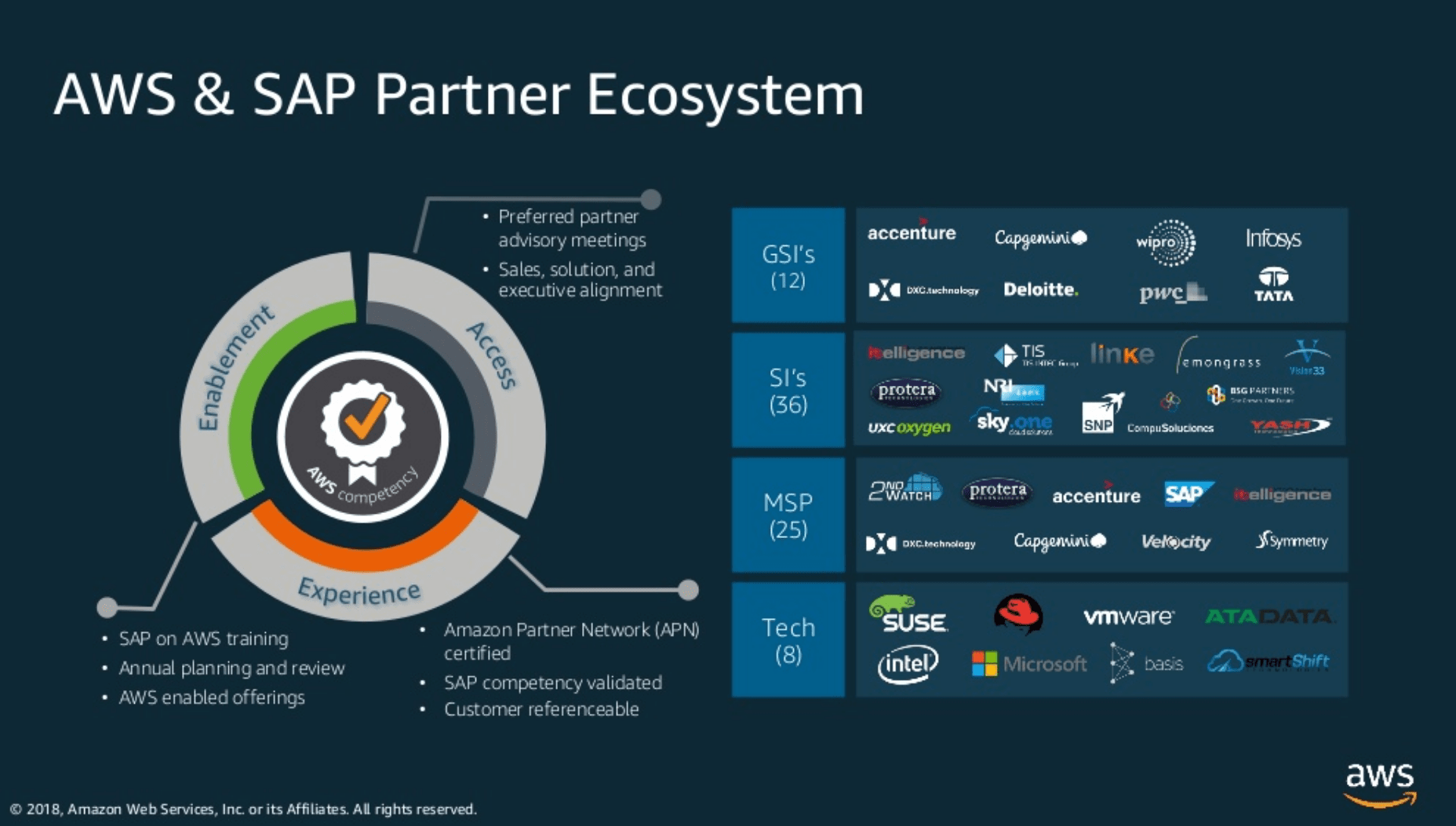
This slide from a presentation by AWS shows a complementary relationship between AWS, SAP, and several partners. However, the reality is quite a bit different. SAP and many of the partners on this slide intend to intermediate between AWS and the final customer.
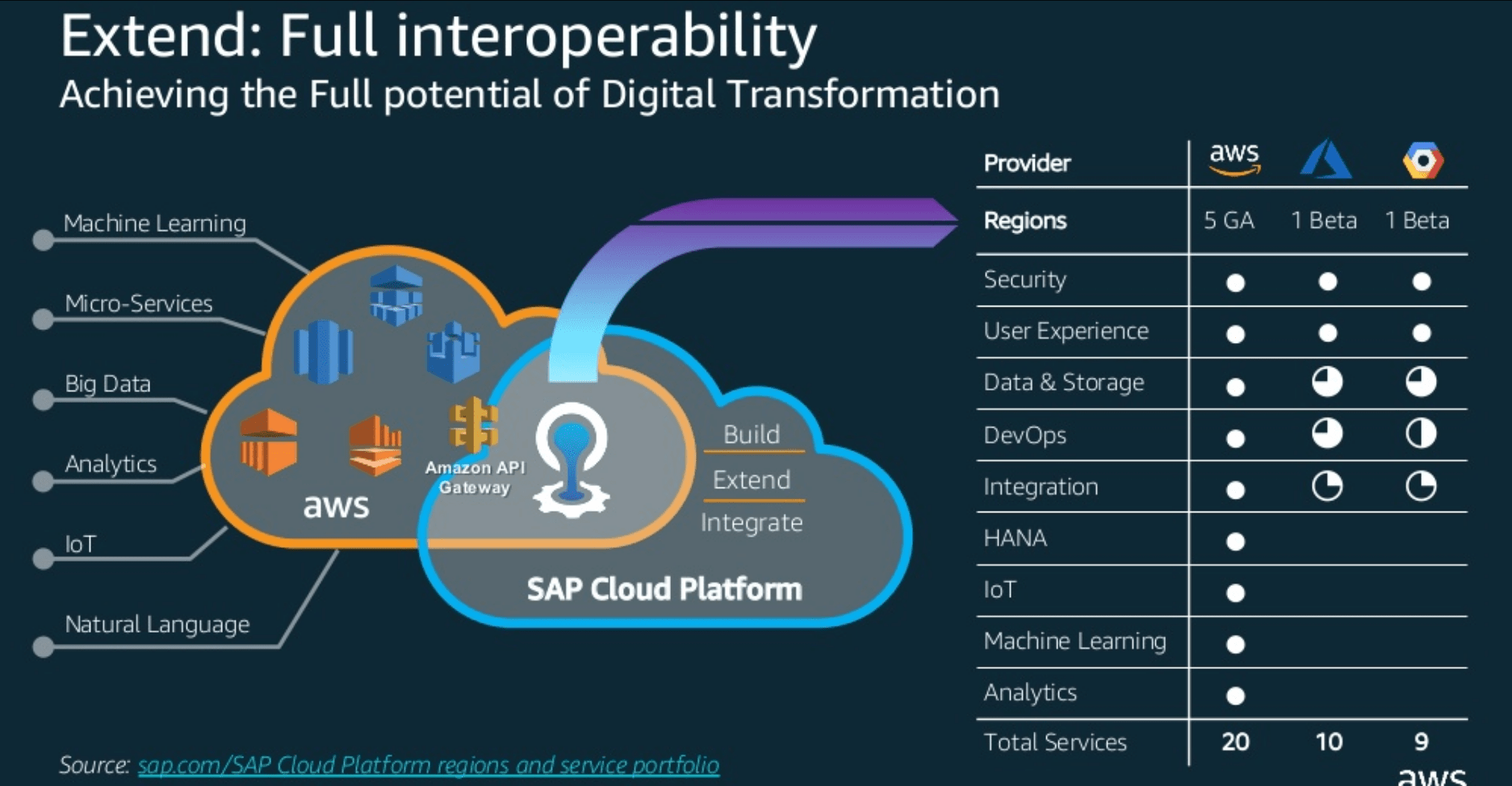
This slide (by AWS) shows what is feasible but not necessarily what is desirable for customers. Under the scenario where the SAP Cloud is the origination, the prices are dramatically higher. The table to the right shows that AWS claims a far more complete offering than GCP or Azure.
All of SAP’s recommendations for the cloud come with a markup over the cloud provider, which SAP does not discuss and pretends does not exist.
Why SAP should be marking up cloud services is an exciting topic as they will not do the work. For example, SAP does not make a margin on the IT department for an on-premises implementation (that is, SAP cannot say, pay us 2x of your internal cost to host our applications), so, oddly, SAP would ask for compensation for something that has nothing to do with.
The Issue of Dedicated Servers and the Public Cloud
As stated, the matrix does not explain a primary issue: SAP’s internally developed products (not acquired products like Ariba or SuccessFactors) have traditionally run on dedicated servers. This should not be all that surprising. ECC and BW were developed before the public cloud is a delivery mechanism or what we describe as a “hardware modality.” Therefore, moving these applications to the private cloud entails several challenges.
How SAP Uses a Dedicated Server
The primary issue with SAP’s need to use a dedicated server and a primary reason for this is that SAP applications use a dedicated IP address. Private clouds primarily use dedicated servers. However, AWS now also offers dedicated servers.

Amazon/AWS allows for dedicated instances, meaning the instance runs on dedicated hardware. One pays a price premium for this, but dedicated hardware is appropriate in some circumstances. Choosing a cloud service provider with both cloud/shared and dedicated capabilities is desirable. Some people will comment that AWS only offers shared, but that is no longer true. Although there is little doubt that most of AWS’s revenues come from shared services.
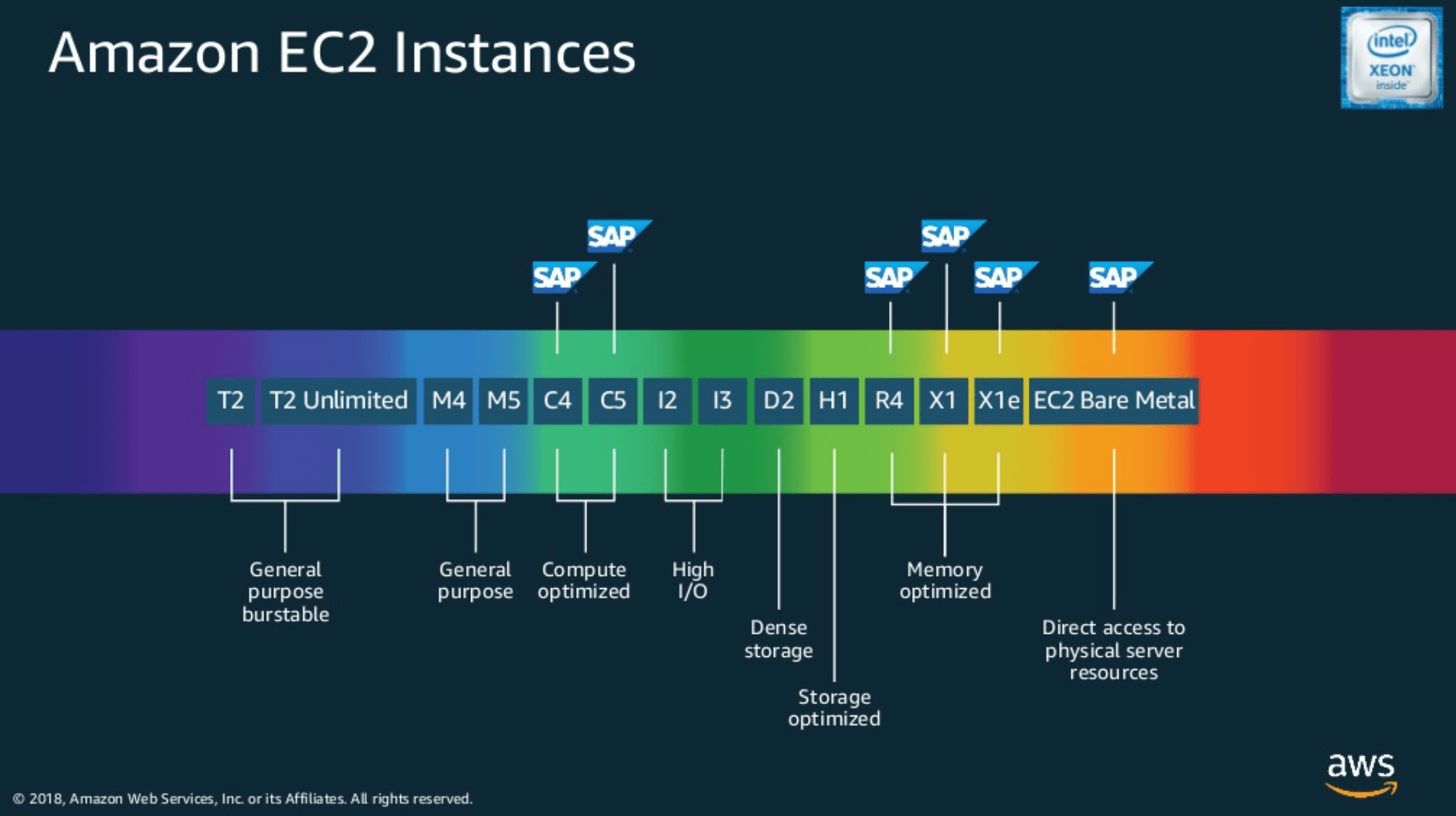
Notice the instances recommended by AWS for SAP. They lean towards “Memory Optimized” or “EC2 Bare Metal” or dedicated.
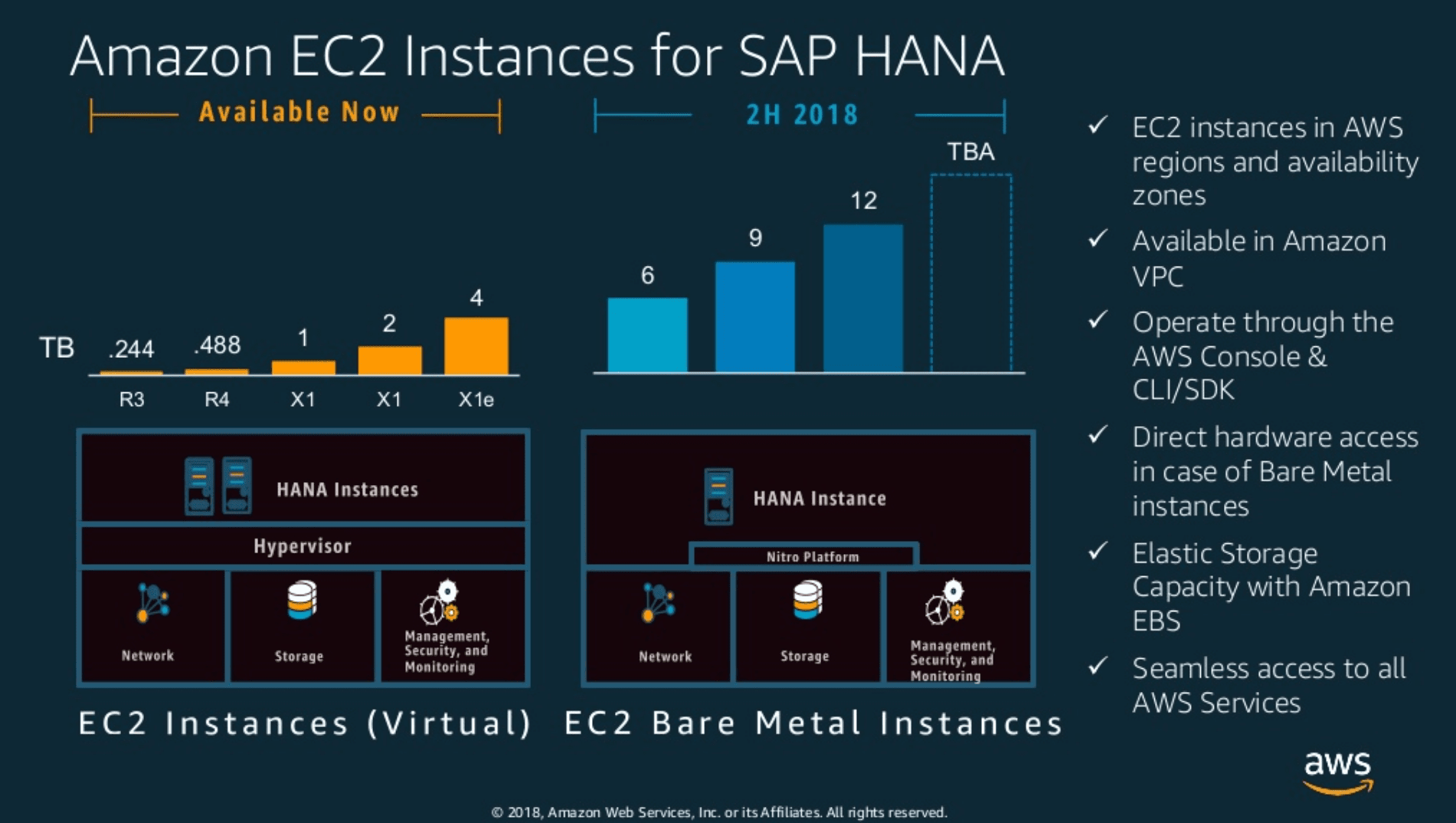
Bare Metal is a recent addition for AWS (notice 2H of 2018 in the slide). However, bare metal is far easier to manage than shared resources. It is more of a matter of installing the bare metal infrastructure.
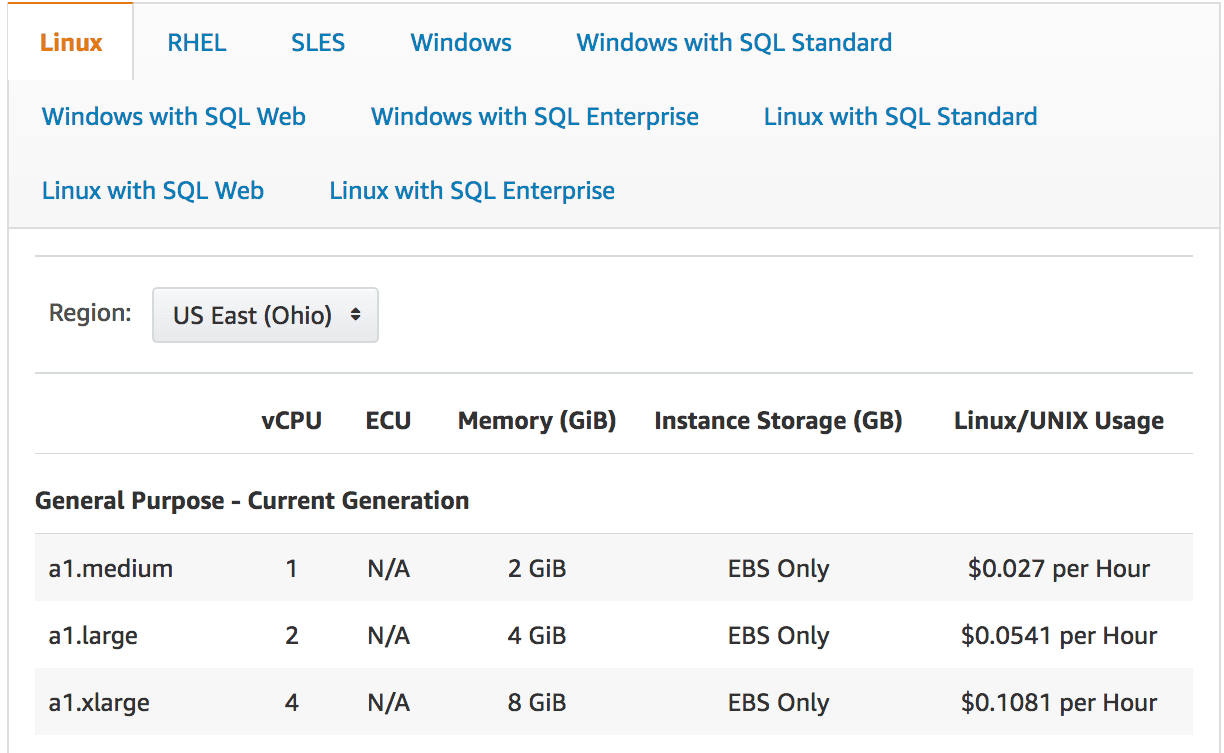
The dedicated instance pricing with AWS is also transparent.
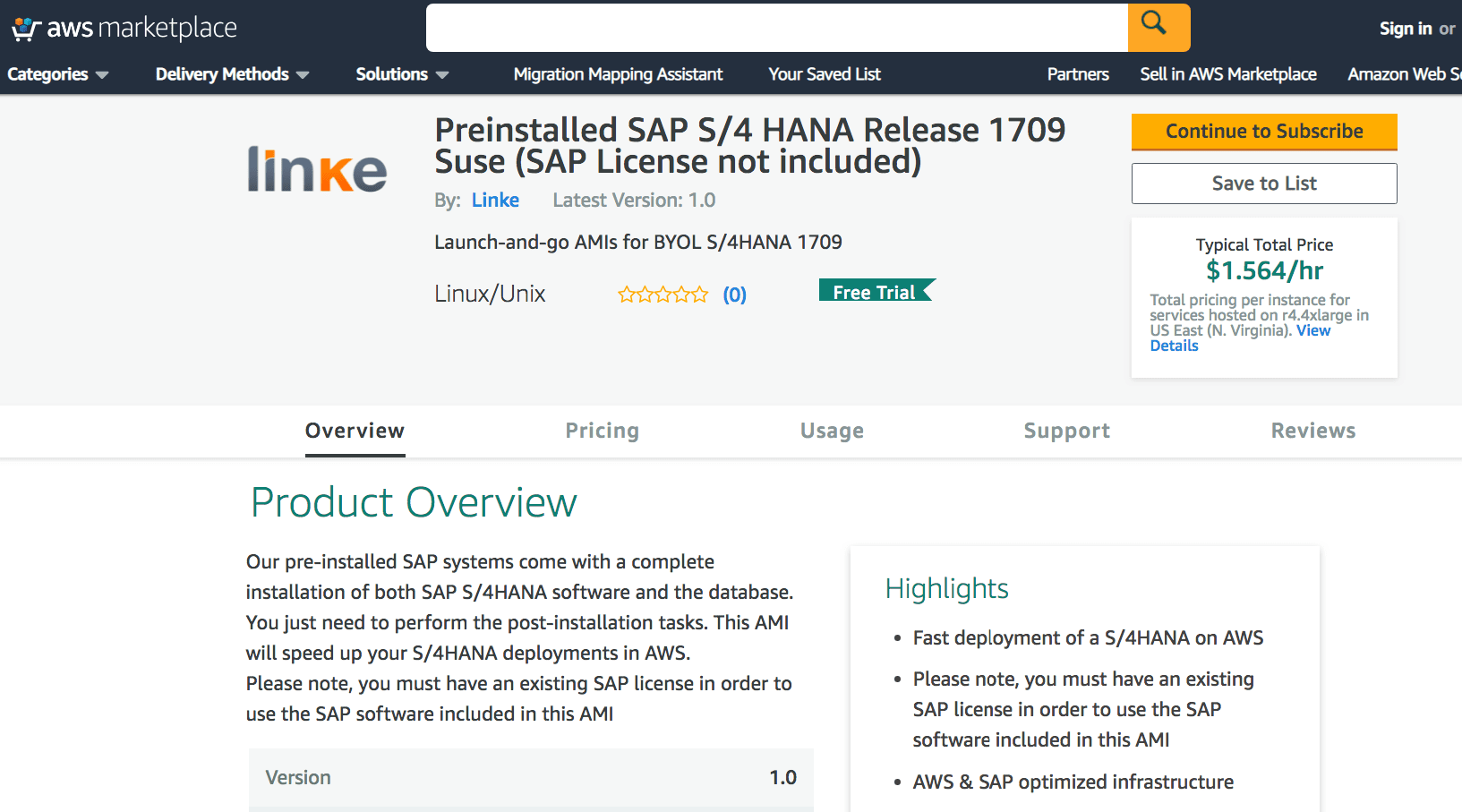
There are instances of S/4HANA that can be used that have transparent pricing. This is called BYOL, or “Bring Your Own License.” A license from SAP could be run on AWS following the BYOL model, which would provide pricing transparency. Under this approach, there is no intermediary.
The price paid by the client would be the AWS price, which is far lower than if SAP plays the middleman.
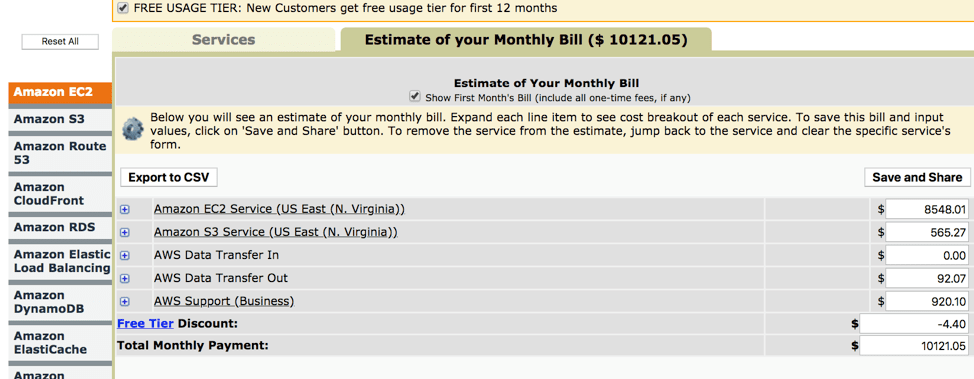
The screenshot above is the largest S/4HANA instance before one moves to bare metal (which, of course, costs more) in AWS. This configuration has 4 TB of memory and 128 virtual CPUs.
AWS Dedicated Instances
Dedicated instances are available from AWS. As for the need for dedicated instances, we will address this issue in two directions.
- Experience from the company AutoDeploy, which migrates customers from on-premises to the public cloud, is that this issue of SAP requiring a static IP is overstated. Some straightward things can be done to adjust for this restriction that can be changed.
This need for a dedicated server is waning. The evidence is that SAP instances can be brought up directly onto cloud/shared instances.
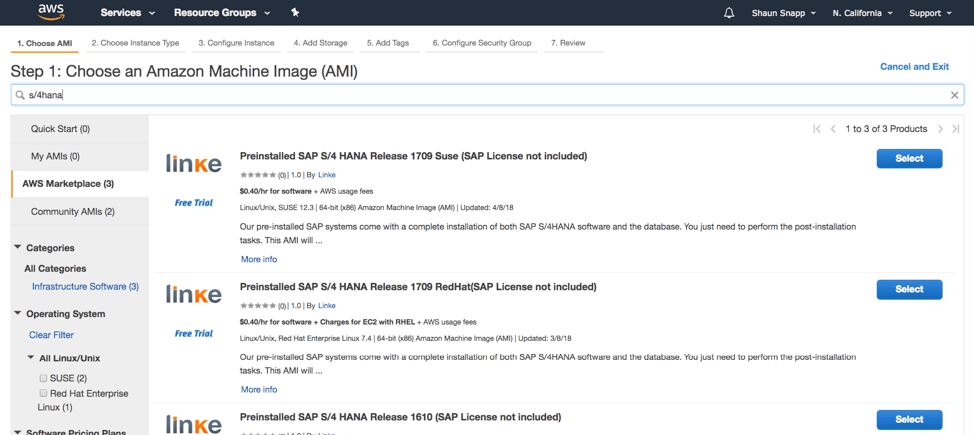
Even though AWS is the largest cloud service provider globally, it does not have very many images for S/4HANA. And the ones they do have are previous versions rather than the latest.
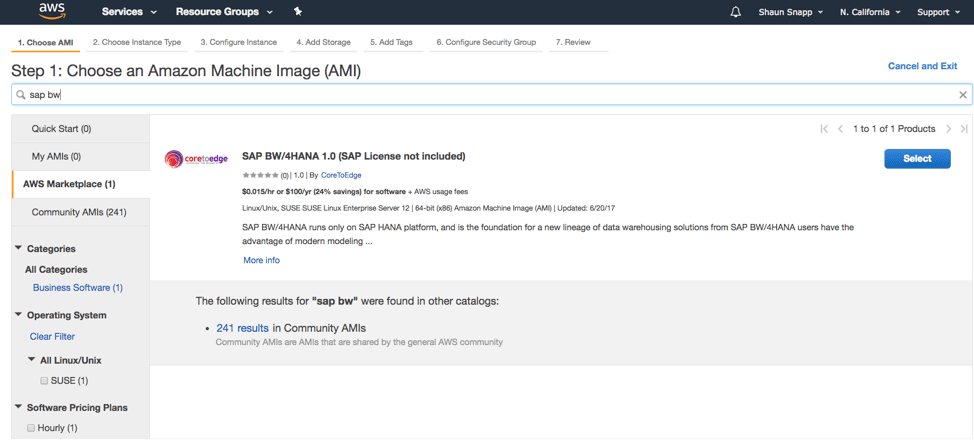
This lack of images extends to BW as well.
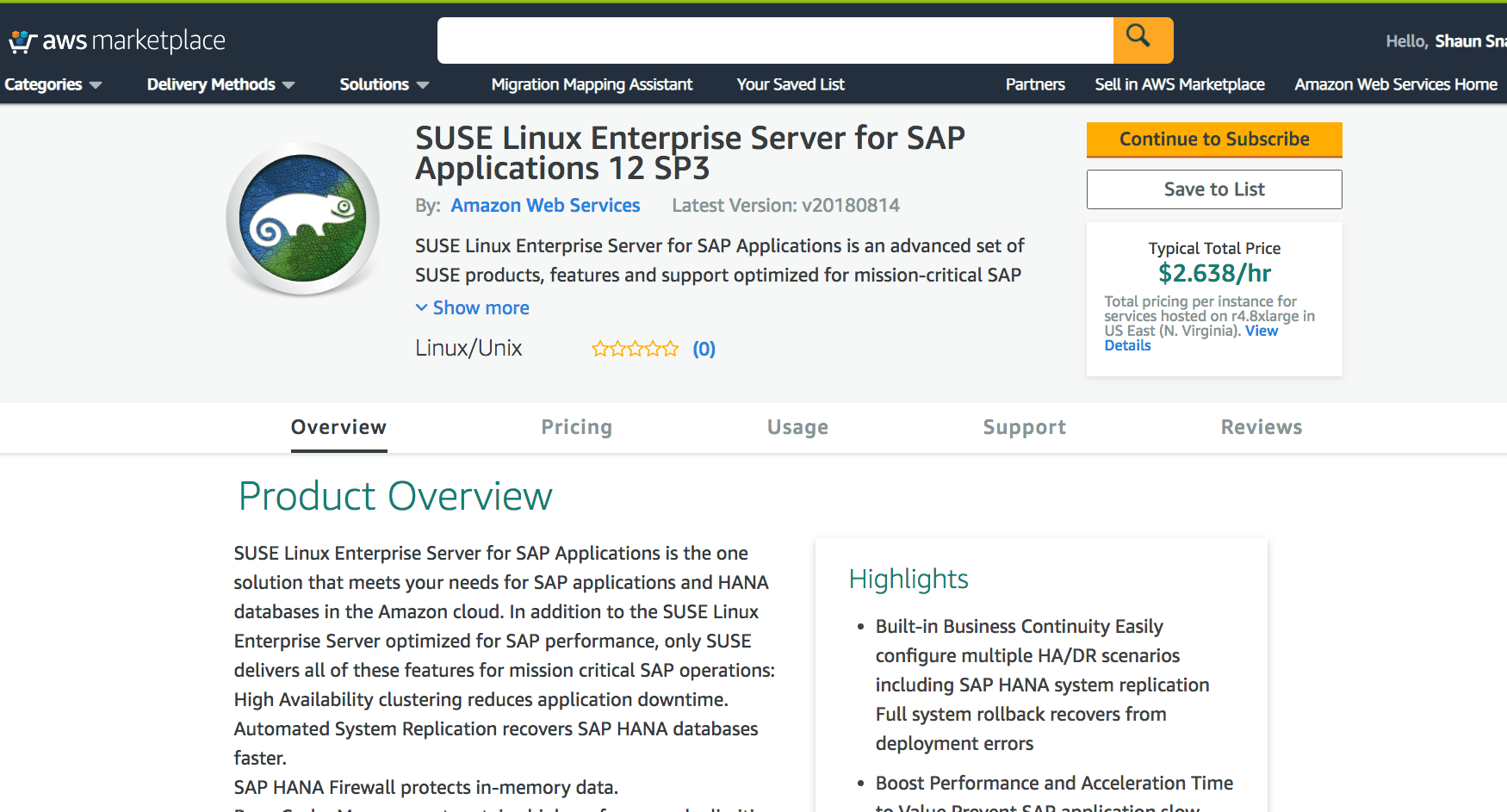
Some of the SAP images aren’t much more than Linux images that have been tuned for SAP. In discussions with companies that move applications out to AWS, they would likely not use these images, as they are restrictive. Instead, they would build their own.
- Interestingly, there are very few images for SAP on AWS outside of HANA and Adaptive Server. This brings up the question of “why.”
- SAP databases aren’t used outside of supporting SAP applications and SAP reporting, which shows a large discrepancy between the SAP database and the SAP applications available on AWS. (And BTW, GCP has like no SAP applications.)
_______________________________________
*Document Note
Containers and Firecracker’s coverage is more technical than maybe digestible for some readers. It is informational for those with the right background—those less interested in optimizing bringing up SAP on the cloud scroll through this section.
_______________________________________
Using Containers & Firecracker
Placing an SAP application on AWS, one would most likely use containers to reduce the number of VMs (virtual machines). Reducing VMs typically has the effect of reducing the price. This is something that one could test before or during the implementation.
- Firecracker is a very lightweight virtualization technology or virtual machine manager that is new but already highly regarded.
- A new item adopted recently and open-sourced by AWS is Firecracker, which could also be tested to improve the cost and performance of placing SAP on AWS.
Firecracker combines the virtues of both virtual machines and serverless (or autoconfigured servers).
Firecracker creates extremely lightweight VMs (called MicroVMs) for the Linux Kernel Virtualization Machine (KVM).
“The number of Firecracker microVMs running simultaneously on a host is limited only by the availability of hardware resources.” – Github
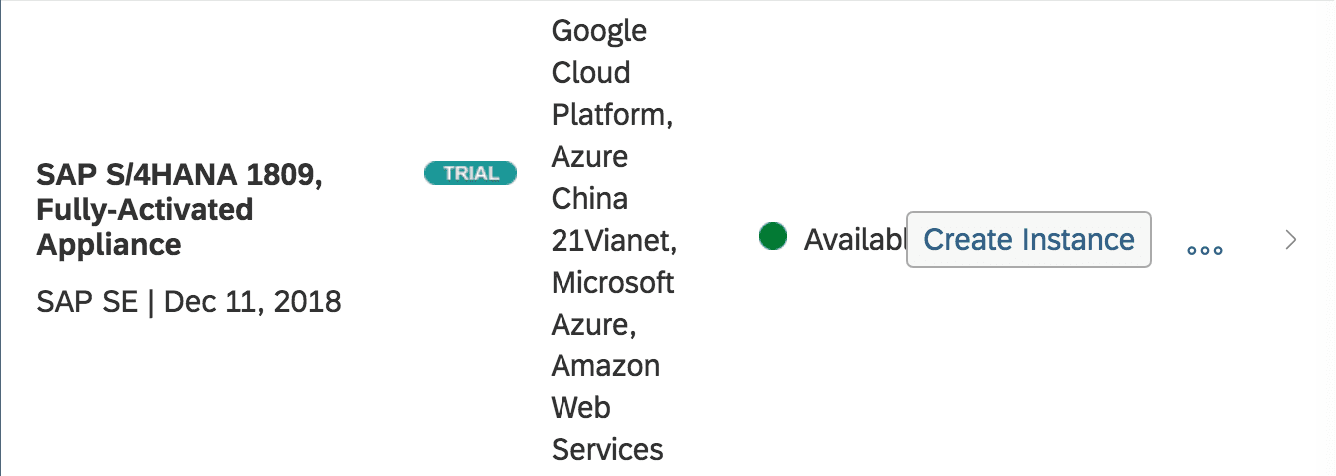
However, from within SAP Cloud, it is feasible to bring up various SAP applications and HANA, where one chooses AWS, GCP, and Azure.

Including BPC 11.
- We brought up S/4HANA 1809. It took 1.5 hours to be available. We found some missing login information restricting our ability to access the application.
- This trial was brought up for testing purposes, but Brightwork recommends against going through the SAP Cloud to move SAP applications to AWS, GCP, or Azure.
Virtustream’s Internal Changes as a Company
The cloud area is growing rapidly, but Virtustream is not growing in US employment and appears to be shrinking. Virtustream is moving to a lower-cost model for its employees with less experience and more offshore resources. Dell’s acquisitions have been hostile to the company and Virtustream customers. (acquired through the EMC acquisition).
The following comment found off of GlassDoor is unheard of in the public cloud space.
“No one is sure of the direction Dell is looking to take this company in, seems they are trying to dissolve. Extremely cut throat atmosphere, major layoffs happening (I heard in the ballpark of 20%). When the most common word that pops up in the company reviews is ‘circus’ that should probably tell you something…”
This quotation also gets to the reputation of Virtustream as a sales-oriented organization that significantly overpromises its ability to deliver.
- Customers should expect lower performance in operations than in the past, as Virtustream is turning over its more experienced technical resources.
- What Virtustream was before, as they readied for acquisition, is not the company that they are presently or will be in the future.
- This will be an issue for the client as delivery will lag behind the promises of Virtustream.
Company Profiles
In this section, we will provide a profile of each company.
AWS
“AWS continues to invest and innovate in the cloud services that it offers. It has evolved to include sophisticated tools for development including machine learning capabilities, a wide range of storage options, IoT and mobile platforms and others. AWS has taken a very proactive approach to compliance with GDPR. AWS global footprint continues to expand to satisfy the needs of its expanding customer base and services offered. It now has: fifty-three availability zones across 18 geographic regions, one local region, and has announced plans for 12 new availability zones and four more regions: Bahrain, Sweden, Hong Kong, and a second US GovCloud region.
The AWS Migration Acceleration Program (MAP) is designed to help enterprises migrating existing workloads to AWS. MAP provides consulting support, training and services credits to reduce risk, to build a strong foundation and to help offset the initial costs. It includes a methodology as well as a set of tools to automate and accelerate common migration scenarios.
AWS has a clear and open approach to security and compliance. It has a very wide range of independent certifications for compliance. AWS has led the CISPE code of conduct to provide clarity to cloud customers around the shared responsibilities for compliance with GDPR and to confirm the steps they are taking to support this.
AWS remains the leading IaaS Global service provider, offering the widest range of services across the greatest number of geographies.” – Ahmed Azmi
AWS Strengths
Strong basic IaaS platform
Rich DevOps capabilities
Speed of innovation of new services
Global footprint for availability and compliance
Hybrid / Private deployment support to cloud enable existing workloads
Independent certifications for a wide range of compliance
Strong security – Ahmed Azmi
AWS Challenges
While AWS has made significant progress in attracting enterprise customers, to retain this leadership position, it must continue to enhance its attractiveness to these customers
Competition from other CSPs that are evolving to challenge AWS position. – Ahmed Azmi
Summary
There is a large amount of public information available regarding AWS. This, combined with testing AWS directly, an advantage to all public clouds, provides a low-risk client option.
Virtustream
Virtustream is a U.S.-based subsidiary of Dell Technologies, is focused solely on cloud services and software. Virtustream was founded in 2008. It was acquired by EMC in July 2015, and EMC’s managed services and some cloud-related assets were moved into Virtustream before EMC was acquired by Dell in September 2016.
Virtustream’s xStream cloud management platform and Infrastructure-as-a-Service (IaaS) are intended to meet the requirements of complex production applications in the private, public and hybrid cloud. Virtustream is headquartered in New York, NY with major operations in 10 countries.
Virtustream Enterprise Cloud uses patented xStream cloud resource management technology (μVM), to create secure, multi-tenant cloud environments that deliver assured SLA levels for business-critical applications and services. Virtustream provides managed services to help organizations to migrate legacy applications to their cloud platform. It also enables production and mission-critical applications to take advantage of technologies such as Big Data analytics such as SAP HANA and Hadoop, as well the advantages like agility, backup, and disaster recovery offered by cloud computing.
Virtustream Enterprise Cloud offers assured application level SLAs with up to 99.999% availability. High levels of security are provided as standard including 2-Factor authentication; Intel TXT Trusted Computing, separate application zones, integrated GRC, and continuous compliance monitoring. Flexible deployment options from the private cloud (on-premises), virtual private cloud, public cloud, public plus private cloud (hybrid) and trusted federated cloud exchange. The Virtustream offering is SAP certified and is independently certified as being compliance with a wide range of regulations and laws. – Ahmed Azmi
Virtustream Strengths
Innovative platform for migration and deployment of complex applications
Managed services available to support this migration and deployment
Strong security and compliance characteristics
Backing from Dell Technologies – Ahmed Azmi
Virtustream Challenges
Focus on enterprise workload migration rather than DevOps.
Differentiating their offering against the major CSPs evolution towards enterprise solutions. – Ahmed Azmi
Summary
Virtustream has a limited footprint and inadequate DevOps and automation compared to AWS. The innovation rate is low, and the company faces sustainability issues internally due to its management.
The key to Virtustream’s differentiation is bundling services like migration, maintenance, and upgrades with hosting, so the customer must deal only with Virtustream. AWS has a far superior IaaS, global presence, and automation capabilities. Also, AWS offers a full range of analytics and databases, and more so, the customer will get access and grow on AWS-integrated products. However, AWS provides services via partners, so customers must work with two providers rather than one.
Offerings
Virtustream Enterprise Cloud is hypervisor-neutral but typically supports VMware and KVM. It is offered in both single-tenant and multitenant variants; furthermore, it can support single-tenant compute with a multitenant back end, as well as bare metal. VMs are available by the hour, bare metal is available by the month, and both paid-by-the-VM and SRP models are available. The offering embeds a tool for governance, risk management and compliance (GRC) leveraging capabilities from Virtustream’s Viewtrust software. A similar offering, Virtustream Federal Cloud, targets U.S. federal government customers. The Virtustream Storage Cloud offers S3-compatible object storage that can integrate with some EMC storage products. Managed services are optional. Virtustream also offers its CMP, xStream, as software. – Ahmed Azmi
Locations
Virtustream has multiple data centers in the eastern and western U.S., the U.K., France, Germany, the Netherlands, Australia, and Japan. It has a sales presence in the U.S., the U.K., Ireland, Germany, Lithuania, Australia, India, and Japan. Virtustream’s service portal is provided in English, German, Japanese, Lithuanian, Portuguese and Spanish. Documentation and support are provided in English only. – Ahmed Azmi
Cautions
Virtustream’s roadmap is inextricably tied into other Dell entities, such as VMware, EMC, and Pivotal, which each have their own sets of differing, and possibly competing, priorities. Customers should treat Virtustream as a specialized provider for the workloads that suit the strengths and weaknesses of its technology platform.
Although Virtustream supports self-service capabilities, it primarily targets complex, mission-critical applications where it is likely that the customer will purchase professional services assistance for implementation, and managed services on an ongoing basis.
Virtustream is a compelling and unique provider for particular enterprise application use cases, but it is better suited to implementations where an environment will be carefully and consultatively tuned for the needs of particular applications, rather than general-purpose environments where workloads are deployed without oversight. Prospective customers should ensure that they have a clear understanding of roles and responsibilities and that their expectations match what is actually written in the contract. – Ahmed Azmi
Gartner’s View of Virtustream and AWS
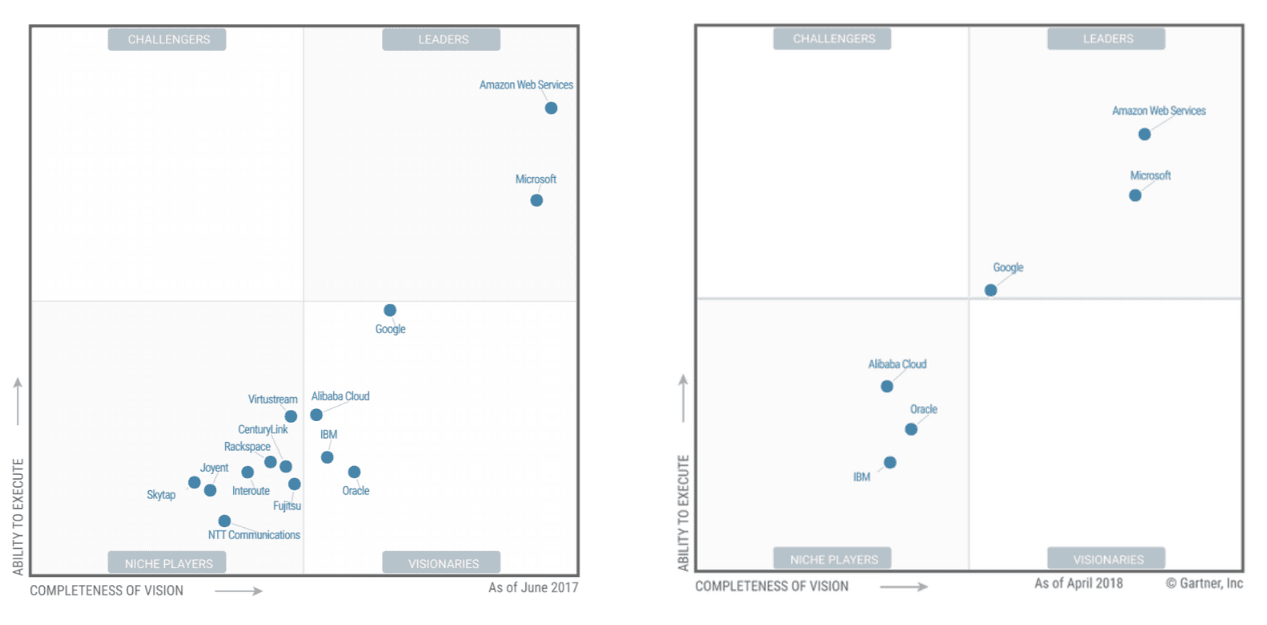
Observe the discrepancy between AWS and Virtustream. In many Gartner Magic Quadrants, the fees paid to Gartner are instrumental in determining the ranking. However, these MQs match our viewpoints, and neither AWS nor Google are significant contributors to Gartner. Microsoft’s funds show their impact because we do not see Microsoft anywhere near AWS, and they are significantly behind Google/GCP in the offering. However, Microsoft/Azure is larger due to Microsoft’s ability to cross-sell existing customers into Azure.
Conclusion
Whichever way the client decides to go, Brightwork thinks the client must accurately represent these two providers.
Much of the decision is also related to how much the client wants to control their cloud services versus everything managed. Virtustream, by the nature of its business model, will provide less transparency than AWS as to the cloud services, as AWS is entirely open to customers. With Virtustream, the infrastructure and the services are combined with one company. With AWS, one can select from many partners ranging from “white-gloved” to smaller partners that tend to provide more specific technical support. Virtustream and AWS appeal to very different types of customers.